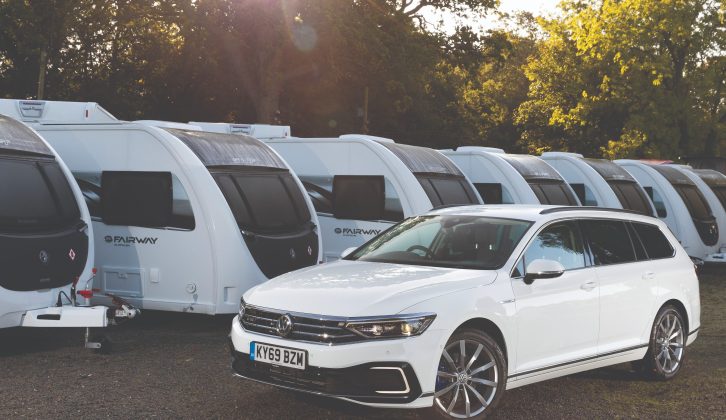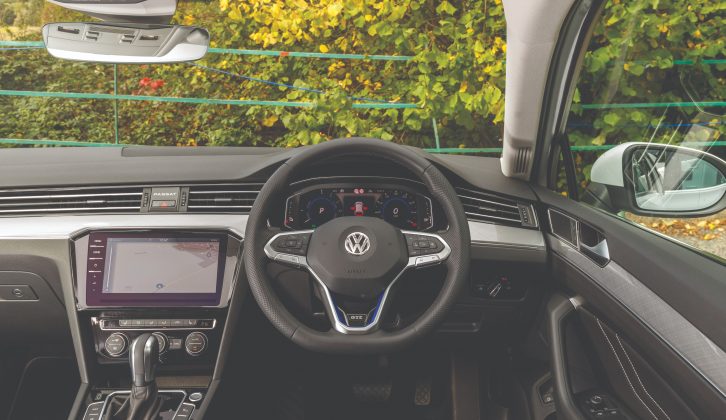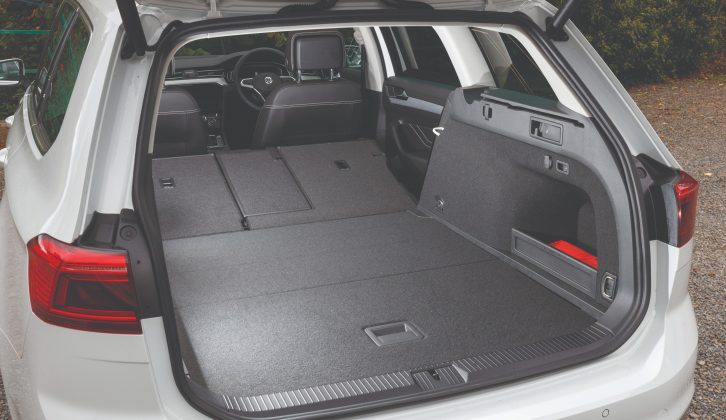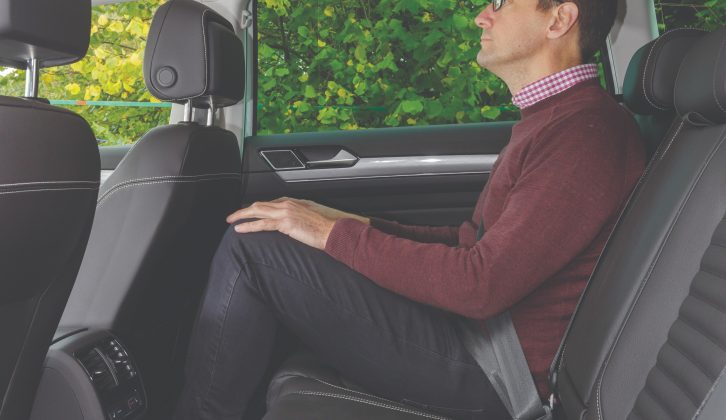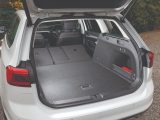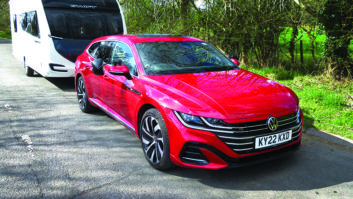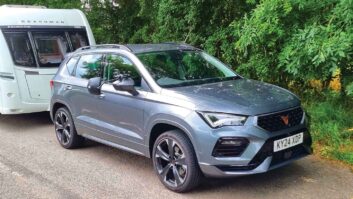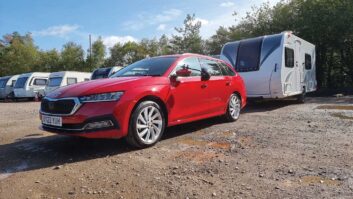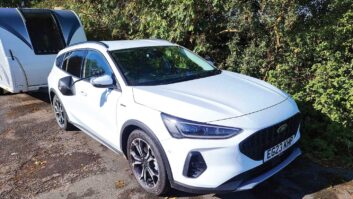Verdict
For high-mileage use, we’d still prefer a diesel Passat. However, for someone who covers relatively few miles during the week, but nonetheless needs a capable and practical tow car, the Passat GTE makes a lot of sense.
It’s really addictive to waft around town accompanied by the distant hum of an electric drivetrain. The instant response from the electric motor and the quiet in the cabin makes the GTE a rather pleasant way to travel from A to B.
And when you do call on the engine, the switch from electric to petrol-electric power is close to seamless.
The 1.4-litre engine punches above its small capacity and it’s smooth and refined. It’s a lot quieter than the 2.0-litre engine in the Mitsubishi Outlander PHEV.
It tows very well, too. There’s plenty of performance, even when the battery is running low. We’ve come to expect stability from the Passat, and the GTE doesn’t disappoint. Caught by a crosswind or while an HGV rumbles past, movements are slight and quickly brought under control with little intervention from the driver.
Inside, VW hasn’t made any radical changes. Instead, it has consolidated the roomy cabin with minor updates.
The GTE Advance isn’t cheap, and it doesn’t help that the government’s plug-in car grant is no longer available for hybrids. But it is extremely well equipped and – for the right driver – the relatively high price will be offset by rock-bottom running costs. We rate this as the best petrol-electric hybrid we’ve tested to date
Pros
Pleasant drive
Tows well even when battery is running
Extremely well equipped
Cons
Relatively high price
Volkswagen’s Passat has enjoyed a mid-life update, with some styling tweaks, more technology, and the reintroduction of the GTE plug-in hybrid.
Before the facelift, sales of the petrol/electric-powered GTE had been suspended as VW could not keep up with demand. The manufacturer says the supply problems have now been solved, and it expects one-in-four Passats sold to be GTEs.
It’s available as a saloon or an estate, and we’re testing the load-hauling version. In Advance spec, the car is priced at £40,470.
We want to find out if the Passat GTE is well suited to long journeys with a caravan, as well as the short trips with frequent battery top-ups.
Performance is very strong. Once both power sources are at work, the GTE rapidly pulls a caravan up to speed
Towing
VW hasn’t simply reintroduced the GTE: there are worthwhile improvements in its specification. The most significant is the higher-capacity battery, rated at 13kWh rather than 9.9kWh in the old model.
This means the car can now travel further on battery power alone, with a range of 33 miles under the tougher WLTP test standard. It will also reach 87mph running as an electric vehicle – clearly, this is not something that would be wise or legal in this country, but it does point to the strength of the electric motor.
That motor is punchy enough to pull a sensibly matched tourer with no help from the petrol engine, as we found out when we collected a Swift Challenger 590 with a MiRO of 1450kg. That’s just a little below the 85% match figure of 1496kg, based on the GTE’s healthy 1760kg kerbweight.
So long as the battery is sufficiently charged, the GTE always starts in E-mode, which runs the car as a zero-emission vehicle for as long as possible. We towed for a mile or two in E-mode before switching to the hybrid setting, which uses the electric motor and the petrol engine as needed.
With a full battery, the petrol engine is by no means always working, even in hybrid mode. When it does wake up, it does so smoothly and unobtrusively. You can hear the engine, but the 1.4-litre petrol is quiet and refined. Even under hard acceleration, it’s much less vocal than the 2.0-litre engine in the Mitsubishi Outlander plug-in hybrid.
Performance is very strong. There’s sometimes a moment of hesitation as the engine wakes up, but once both power sources are at work, the GTE rapidly pulls a caravan up to speed. It’s easy to maintain pace on hilly roads, or to reach 60mph on the motorway.
Even with the battery’s reserves largely depleted, the Passat performs well. The dashboard display will eventually show an electric-only range of zero miles, but the battery doesn’t run completely flat, and it recharges whenever the car is slowing down or braking. It can also use the petrol engine as a generator.
The upshot is, there’s still an acceleration boost from the electric motor, even after towing a long distance.
We tested the GTE’s hill starting with the battery almost flat. The electronic parking brake held car and caravan still on a 1-in-10 slope, and the car pulled away smoothly, if not especially quickly.
Unlike the Mitsubishi Outlander PHEV, the Passat is a two-wheel-drive car. For all-weather towing, it’s a shame that the electric motor doesn’t drive the rear wheels, to give more traction when roads are wet.
We’ve towed with many VW Passats, and have always found them to make stable tow cars. The GTE is no exception. In still air, it tracks straight and true, although we could feel some slight side-to-side movements when overtaking high-sided vehicles. However, it quickly recovered and pulled the caravan straight again.
Choose the optional Trailer Assist package (£500) and the car will steer the caravan onto a pitch without the driver touching the wheel, although you still need to instruct the system how far to turn and take care of the throttle and brake.
Hitching up is easy, thanks to plentiful clearance around the drop-down towball (£930) with integrated electrics.
Everyday Driving
In everyday driving, the Passat GTE works best for somebody with a low daily mileage and their own home charger, because this will allow the car to be run on electric power alone most of the time, with very low running costs.
Although the official range is 33 miles, how far the GTE will go between charges is heavily dependent on how it is driven, and the temperature. On a chilly morning, the dashboard display suggested a 20-mile range, even with the battery fully charged.
Driven as an electric car, the Passat makes quiet and serene progress. It pullaway briskly without assistance from the petrol engine.
In hybrid mode, performance is impressive; the maximum combined power output of the petrol engine and the electric motor is 218PS (215bhp).
The car feels liveliest once the GTE button has been pressed, which prioritises performance over ultimate economy, sharpens the throttle and gearbox responses, and adds weight to the steering.
All in all, the Passat is a very satisfying vehicle to drive, with a broad range of talents, especially if you opt for the Dynamic Chassis Control system (an £895 option). This gives a choice of suspension settings for maximum comfort or a sportier feel.
Charging the car will be easiest if you have a wall box installed at home. This will allow the GTE to charge fully in 3.5 hours.
Other than choosing between the E, hybrid and GTE modes, there’s really nothing more complicated about driving the GTE, compared with any other automatic Passat. It’s very easy, relaxing and quiet.
Space
There are some slight tweaks inside, such as the Passat logo in the centre of the dashboard and the second-generation digital cockpit display instead of conventional dials. However, it’s not a wholesale revision – the cabin didn’t need it.
The general standard of finish is high, and the driving position is comfortable, even over long distances. We found the driver’s seat very supportive and ended a long day behind the wheel without any aches and pains.
There’s more than enough head- and legroom up front, so even very tall drivers can be accommodated.
Those in the back are scarcely worse off, and benefit from their own climate control settings, as well as vents between the front seats. However, the sizeable transmission tunnel could get in the way if you are carrying three passengers in the back.
The GTE’s boot is smaller than that in the standard Passat Estate, although it should still cope with a family’s holiday bags. To preserve boot space, VW has chosen to equip the GTE with a tyre repair kit rather than a spare wheel, which won’t be popular with caravanners. But otherwise, this is a very practical car.
Running Costs
For a family estate car, the Passat GTE is rather costly. In Advance spec, it costs £40,470, although What Car? suggests big discounts are available.
What’s more, few other estates combine such high performance with the potential for low running costs.
The savings are especially compelling for company car drivers, with a benefit-in-kind tax rate of 16% for the current tax year.
You’ll need to recharge the car regularly to achieve the 180.8mpg official combined figure. We saw around 42mpg on a long motorway run. Over a 73-mile long economy test while towing, starting with a full battery, we achieved 29.5mpg. That’s much better than we’ve achieved with petrol-electric plug-in hybrids in the past.
The car is very well equipped with luxury toys and safety systems, and has a five-star rating from Euro NCAP.
Technical Specifications
| Engine Size | 1395 cc |
| Kerbweight | 1760 kg |
| 85% KW | 1496 kg |
| Towball Limit | 90 kg |
| Maximum Towing Limit | 1600 kg |
| Power | 148 bhp |
| Torque | 184 lb ft |
| Offical MPG | 180.8 mpg |
| CO₂ | 39 g/km |
